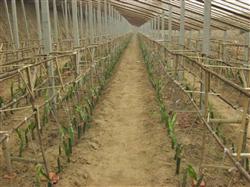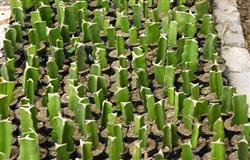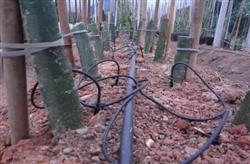Key techniques of cultivation and management of dragon fruit in greenhouse

Dragon fruit is also known as red dragon fruit, green dragon fruit, Xianmi fruit and so on. At present, the main cultivated varieties are white dragon fruit, red dragon fruit, yellow dragon fruit. The dragon fruit is very nutritious, which mainly contains vitamins, cellulose, glucose, carotene, fat, amino acids and minerals such as phosphorus and iron needed by the human body. it has the functions of detoxification, moisturizing intestines and stomach, clearing blood, lowering blood pressure, lowering cholesterol, preventing vascular hardening, constipation, anemia, angular stomatitis and colds, as well as beauty, beauty and anti-aging. Fire dragon fruit is not only a treasure of fruit, because of its large flower shape, white, bright red fruit, but also a rare top grade of flowers. The key points of greenhouse cultivation techniques are as follows. The main results are as follows: (1) the greenhouse can be constructed by Langfang 40 solar greenhouse, which has the characteristics of high light transmittance, strong thermal insulation and low construction cost. The greenhouse covers an area of 80 meters from east to west and 18 meters from north to south. The greenhouse is 5-100 degrees west to the south, which is conducive to daylighting. The rear wall of the greenhouse is 2.8 meters high, 4.5 meters wide at the bottom, 2 meters wide at the top, 0.7 meters at the bottom, 3.5 meters at the highest point of the east-west gable, 2-3 meters thick, and 7.25 meters across the greenhouse. Greenhouse wall construction can use mechanical operation, each cushion soil 40-50 cm, rolling 6-8 times, about 4-5 layers of cushion soil, and then manual repair, so that the inner wall is straight, the outer wall is gentle and solid. Put an iron arch beam every 1.5 meters, the arch beam is mainly supported by the middle column and the front and rear fixed piles, the rear roof projection is 0.8 meters, the inclination is 45 degrees. 1.2 meters deep anchor ditches were dug on the east and west sides of the greenhouse, with 23 anchors on each side. The front and rear slopes were strung with 23 channels of No. 8 galvanized wire, of which 16 were on the front slope and 7 on the back slope. The back slope is laid with 30 cm thick corn straw, and the corn straw is covered with 30 cm soil. Qianpo string cable is fixed with a 7-meter bamboo pole as an arch, then covered with PVC non-dripping film, and then pressed with a pressing film line, covering 4 cm thick grass grass in early winter, with a coverage rate of 150%, covering 4 layers of Kraft paper from January to February, and a coverage of 110%. In case of snow, a layer of old film should be covered to prevent the grass from being too wet to affect the heat preservation. (2) Seedling planting dragon fruit belongs to vine cactus family, which must be set up for climbing and growth when cultivated artificially. First of all, 305 1.3-meter-high cement piles were buried in the greenhouse according to the plant spacing of 1.2 meters and row spacing of 1.5 meters, and 2 pitaya seedlings were planted on each cement pile. Before planting, 12 cubic meters of crude fertilizer was applied in each greenhouse, 50 kg of diammonium phosphate was used as base fertilizer, and enough water was poured after planting. (3) cultivation and management ① watering pitaya is a drought-tolerant plant. When the relative water content of the soil reaches 70%, 80%, it can grow normally, but the waterlogging tolerance is poor. If the root is waterlogged for a long time, it will cause rotting roots, resulting in reduced production or death. When watering, we should grasp the principle of not drying, watering and watering thoroughly. In addition, in the process of growth, the fruit should not be watered when it is not sitting, and it should be watered once every 15-20 days when the fruit grows to the size of the egg. Due to the vigorous growth and annual results of dragon fruit, ② fertilization needs more fertilizer. In order to ensure the fruit quality and yield, we must adhere to the principle of organic fertilizer and chemical fertilizer. In the case of sufficient base fertilizer, topdressing should be done every 15-20 days after entering the fruiting period, and attention should be paid to the cross between organic fertilizer and chemical fertilizer. Attention should be paid to balanced fertilization to ensure complete nutrients and fully meet the needs of plants for all kinds of nutrients. There are many methods of topdressing, such as ring topdressing, radial topdressing, irrigation topdressing and foliar topdressing. The root system of dragon fruit is different from other fruit trees, there is no strong main root, it is whisker root, and the root system is very shallow, which is basically distributed in the surface layer of soil. Therefore, special attention should be paid not to damage the root system when topdressing. After ③ pruning pitaya seedlings were planted, they could germinate and grow rapidly after about 15-20 days. In the growth process will breed a lot of buds, the formation of disorderly lateral branches, if not pruned in time, it will affect the normal growth of the plant. When the dragon fruit is pruned, only one trunk is left, and all the other lateral branches are cut off to ensure the normal growth of the trunk. When the trunk reaches 1.3-1.5 meters high (the trunk height should be about 1 meter when cultivated as potted flowers), it should be topped to force it to produce lateral branches. these lateral branches are fruit branches. According to the status of plant growth and environmental conditions, about 20 fruiting branches can be left per plant, and 3 fruits should be left for one fruiting branch. If the fruit setting distance is less than 15 cm, one of the weak fruits can be removed to ensure the normal growth of other fruits. After entering the full fruiting period, all fruiting branches should be cut off to reduce nutrient consumption. (4) pest control pitaya is wild in its origin and has a strong ability to resist diseases and insect pests. After being introduced into China, no serious diseases and insect pests have been found, but snails and slugs often nibble on its tender branches. it can affect the growth of pitaya, and lime can be used to control it. if the population density is high, poison bait can also be used. When the fruit is ripe, the fruit fly often lays eggs in the fruit epidermis, resulting in fruit cracking and rotten fruit. The control method is to hang sticky fly paper on the branches, trap and kill flies, or spray with biological pesticide "Qianchongg" 800 times liquid, the effect is also ideal. (5) it takes 30-40 days to harvest and store dragon fruit from flowering to ripening. When the pericarp turns red and shiny, it can be harvested. When harvesting, cut off the fruit stalk with the fruit shears close to the branches, and it is best to retain the fruit stalk in order to reduce the nutrient consumption of the fruit in the process of storage and transportation; after harvest, put it gently in the fruit basket to minimize mechanical damage. The dragon fruit is resistant to storage and can be stored at room temperature for more than 15 days. if it is stored at 10-15 degrees Celsius in the fresh-keeping warehouse, the time can be extended to more than 2 months.
- Prev

Main points of propagation of dragon fruit
The main results are as follows: 1. The cuttings are most suitable in spring and summer. The cuttings should select full stem nodes, which are about 15 cm long. After the wound is air-dried, they can be inserted into the sand bed. About 15 Mel can take root in 30 days, and the roots can grow to 3 Mel and 4 cm transplantable seedbed. 2. The grafted seedlings should be free of diseases and insect pests, strong growth and full stem and flesh.
- Next

Water and fertilizer management of dragon fruit and matters needing attention
The dragon fruit is more drought-tolerant. It is watered every 2-3 days at the initial planting stage, and the soil can be kept moist after that. The root distribution of dragon fruit is shallow, and fertilization should be applied for a few times to prevent root burning and rotting. After the colonized seedling germinates, thin human feces and urine can be applied in the planting hole about 10 cm away from the seedling, about 1 kg per plant, and then germinate every time.
Related
- Moge, come on! The staff of the peasant association in the producing area of cantaloupe were frightened when the crowd gathered.
- Causes and Solutions of low Fruit setting rate of Apple
- Symptoms and control measures of passion fruit virus disease
- Fruit growing lesson: how do apple orchards keep high yields?
- Can you build orchards in the mountains? What are the pros and cons?
- How to manage the coloring period of Crisson grape?
- This paper introduces the processing technology of two kinds of fig products.
- How much is a month for retired teachers in rural areas by 2020?
- How can strawberry planting increase sugar content? We should pay attention to management in many aspects.
- What are the cultivation techniques on how to improve the yield of golden fruit?

